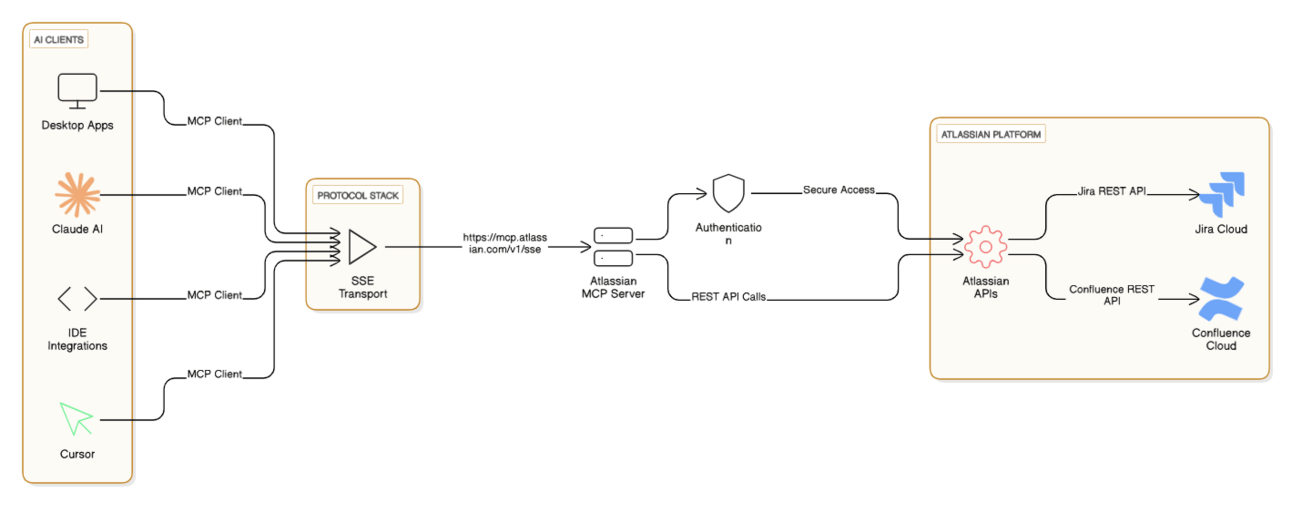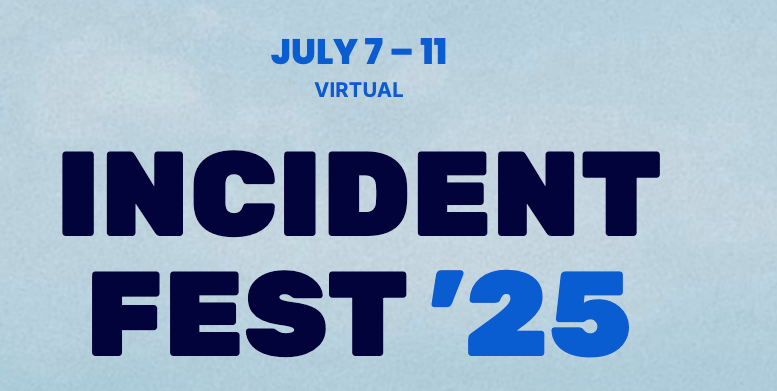- Odyssey Platform Weekly
- Posts
- Odyssey Platform # 07
Odyssey Platform # 07
Another exciting week in the Platform Engineering ecosystem!

Editor's Note
Welcome to another edition of Odyssey Platform Weekly! This week, we’re diving into fresh insights, key events, and powerful stories shaping the future of platform engineering.🗞️ In this newsletter
🗓️ Events
INCIDENT FEST ’25 - Featuring an all-star lineup of incident response classics
🔦 Tool Spotlight
Kyverno is a Kubernetes-native policy engine purpose-built for securing and governing modern container platforms.
🔍️ Deep Dive
Discover how Atlassian's Remote Model Context Protocol (MCP) Server seamlessly connects AI assistants, enterprise data, and secure workflows enabling your teams to query, create, and analyze Jira tickets and Confluence pages through natural language without ever leaving their AI tools. Learn how Atlassian's innovative trinity of Protocol, Security, and Intelligence unlocks zero-friction knowledge management for modern teams.
🎯 Stay Inspired - Case Studies
👀 In Case you missed it
Latest news & events in the platform engineering domain
📆 Upcoming Events
🧠 INCIDENT FEST ’25
📅 Jul 7-11, 2025 – Virtual
A week of on-demand and live-streamed resources focused on the reality of incident response – the kind you don’t often get to hear about on the conference stage. 🔥
👉 Register here

🔦 Tool Spotlight
Kyverno is designed with simplicity in mind, it allows platform teams to define, validate, mutate, and generate Kubernetes resources using familiar YAML — no need to learn a new language like Rego.
With Kyverno, you can enforce best practices, apply security controls (like disallowing privileged containers), and ensure configuration consistency across clusters. It integrates natively with admission controllers, making it ideal for real-time policy enforcement and compliance checks.
Used by organisations like CERN, VMware, and the CNCF, Kyverno is the backbone of policy-as-code for Kubernetes-native platforms — secure, declarative, and GitOps-friendly.

Kubernetes-native policy engine
🚀 From Context Switching to Context Intelligence: Atlassian's MCP Revolution

Atlassian MCP Remote Server
🎭The Atlassian MCP Server Story: A Simple Act in 7 Scenes
Think of this like a restaurant where you order food and it magically appears - but instead of food, you're getting Jira tickets and Confluence pages!
🎬 Meet Our Cast of Characters
👤 You (The Customer)
The person who wants information from Jira or Confluence
Speaks in normal, everyday language
🤖 Claude AI (The Friendly Waiter)
Takes your order and translates it
Speaks both human language and computer language
📞 MCP Client (The Order Taker)
Writes down your order in a special format
Makes sure nothing gets lost in translation
🚚 Protocol Stack (The Delivery System)
Like the restaurant's kitchen-to-table system
Carries messages back and forth quickly and safely
🏢 Atlassian MCP Server (The Kitchen Manager)
Coordinates everything and knows where to find what you need
Lives in a secure, reliable building (Cloudflare)
🛡 Security Guard (OAuth Authentication)
Checks your ID to make sure you're allowed to get certain information
Protects company secrets and private data
📚 Atlassian APIs (The Storage Room)
The organized filing system that knows where everything is stored
Has separate sections for Jira stuff and Confluence stuff
🏪 Jira & Confluence (The Actual Warehouses)
Where all your tickets, projects, and documents actually live
The final destination where your information comes from
🎭 Act 1: The Complete Journey
Scene 1: You Place Your Order
You: "Hey Claude, show me all the urgent bugs that Sarah is working on"
What's happening: You're asking for information in normal human language, just like ordering a sandwich at a deli.
Scene 2: The Waiter Takes Your Order
Claude AI: "Got it! Let me find those urgent bugs for Sarah right away!"
What's happening: Claude understands what you want but needs to translate your request into computer language. It's like a waiter who speaks both English and kitchen code.
Scene 3: Writing the Kitchen Ticket
MCP Client: Creates a structured request that looks like":
{
"action": "search_jira",
"filters": {
"priority": "urgent",
"assignee": "sarah",
"type": "bug"
}
}What's happening: Your casual request gets written down in a precise format that computers can understand - like how a waiter writes "BLT no mayo" instead of "sandwich with bacon, lettuce, tomato but hold the white sauce."
Scene 4: Express Delivery to the Kitchen
Protocol Stack: Carries the request via a secure, fast highway (SSE) to: https://mcp.atlassian.com/v1/sse
What's happening: Your order travels through a super-fast, secure tunnel directly to Atlassian's kitchen. It's like having a pneumatic tube system that instantly delivers your request
Scene 5: The Kitchen Manager Takes Charge
Atlassian MCP Server: "I received an order for Sarah's urgent bugs. Let me coordinate this ."
What's happening: The kitchen manager (hosted safely in Cloudflare's building) receives your order and starts organizing how to fulfill it. They know exactly which storage rooms to check and which workers to ask.
Scene 6: Security Check at the Door
Security Guard: "Let me check your credentials . Yes, you're allowed to see Sarah's bugs, but not the HR project data."
What's happening: Before anyone goes to get your information, security makes sure you're authorized to see it. It's like having a bouncer who checks your ID and membership card before letting you into different sections of a club.
Scene 7: Fetching from the Storage Room
Atlassian APIs: "Going to the Jira warehouse to get urgent bugs assigned to Sarah ."
What's happening: The storage room manager goes to the specific warehouse (Jira) and uses the proper procedure to retrieve exactly what you asked for.
Scene 8: The Actual Warehouse
Jira Cloud: Returns the data:
-BUG-123: Login page crashes on mobile (Urgent, assigned to Sarah)
- BUG-456: Payment form validation error (Urgent, assigned to Sarah)
- BUG-789: Search function timeout (Urgent, assigned to Sarah)
What's happening: The actual warehouse where your company stores all the bug reports, projects, and tickets gives back exactly what was requested.
Scene 9: The Return Journey
The information travels back through the same path: Jira → APIs → Security → MCP Server → Protocol Stack → MCP Client → Claude
Scene 10: Your Order Arrives
Claude: "Here are the 3 urgent bugs Sarah is working on:
🐛 Login page crashes on mobile (BUG-123)
🐛 Payment form validation error (BUG-456)
🐛 Search function timeout (BUG-789)
Would you like me to check the status of any specific bug?"
What's happening: You get exactly what you asked for, presented in a friendly, easy-to-understand way!
🎭 Act 2: A Different Story - Creating Documentation
The Setup
You (Scrum Master): "Claude, create a sprint retrospective document for Team Alpha's last sprint"
The Journey🚀
You place the order - "I need a retrospective doc"
Claude translates - "User wants to create a Confluence page with retrospective template"
Order gets formatted - Creates structured request for page creation
Express delivery - Sent to Atlassian MCP Server
Kitchen manager coordinates - "This is a creation request, route to Confluence"
Security checks - "User has permission to create pages in Team Alpha space"
Storage room processes - Confluence APIs prepare to create the page
Warehouse creates - Confluence actually creates the new page
Confirmation travels back - Success message returns through the chain
You get confirmation - "Retrospective doc created! Here's the link: ."
🏆 Why This System is Amazing for Scrum Masters
⚡ Speed
Instead of clicking through 5 different screens in Jira, you just ask Claude and get instant results.
🎯 Accuracy
The system follows your exact permissions - you only see what you're supposed to see.
🔄 Efficiency
You can do multiple tasks at once: "Show me blocked tickets AND create a status report AND find related documentation"
📊Intelligence
Claude can analyze patterns:
"Which team member has the most critical bugs?"
"What's our average story completion time this sprint?"
Security Made Simple
Think of it like a hotel with multiple levels of security:
Front Desk (OAuth) - Checks your keycard
Elevator (MCP Server) - Only goes to floors you have access to
Room Access (APIs) - Each room (Jira/Confluence) has its own lock
Room Service (Permissions) - You only get what you're authorized to receive
Your data never goes anywhere it shouldn't, and you never see anything you're not supposed to see.
🎪 Real Scrum Master Scenarios
📅 Daily Standup Prep
You: "What tickets were updated since yesterday's standup?"
Result: Instant list of all changes, no manual checking required.
🚀 Sprint Planning
You: "Show me all unassigned high-priority stories in the backlog"
Result: Perfect list for sprint planning discussion.
📊 Retrospective Data
You: "What were our biggest blockers this sprint and how long did they take to resolve?" Result: Data driven insights for better retrospectives.
📈 Progress Updates
You: "Create a status report for stakeholders about the mobile app project"
Result: Professional report generated instantly with current data.
💡 Think of It Like This
Traditional Way: You're a detective who has to visit multiple buildings, show ID at each one, search through filing cabinets, take notes, and compile a report.
MCP Way: You have a super-smart assistant who knows every building, has all the right keys, speaks the language of each department, and brings you exactly what you need in seconds.
The magic is that you just talk to your assistant in normal language, and they handle all the complex stuff behind the scenes!
🎯The Bottom Line for Non-Technical Folks
You talk normally - No special commands or technical jargon
AI understands - Converts your request to the right format
System finds info - Safely searches through your authorized data
You get results - Information presented clearly and quickly
It's like having a super-powered assistant who never sleeps, never forgets, and has instant access to all your project information! 🚀
🎯 Stay Inspired - Case Studies
🔹 MLOps helping KONUX excel in predictive maintenance operations 🚀
KONUX combines IIoT sensors with ML to monitor rail vibrations. Their system identifies trains and detects anomalies before failures occur—ensuring safety, reducing downtime, and extending infrastructure lifespan. Read more here.
✅ Experimentation at scale: KONUX runs 10× more experiments with the same engineering effort thanks to Valohai’s orchestration and experiment tracking, enabling rapid model iteration.
✅ Infrastructure freedom for data teams: Engineers no longer handle manual provisioning or monitoring—Valohai automates resource allocation and teardown—freeing them to focus on modeling.
✅ Robust traceability & reproducibility: Full experiment lineage and metadata capture ensure every model is traceable and reproducible—critical for production-grade MLOps governance.
✅ Innovation culture fostered: With 15 % of time allocated to “moonshot” projects, KONUX empowered engineers to explore breakthrough ideas, tracked and surfaced via Valohai’s system.
👀 In Case You Missed It…
Advanced GPU support, hardware-aware scheduling, and GPU partitioning is making Kubernetes a stronger universal platform for both app and ML workloads
Explore the merging of DevOps best practices with MLOps workflows to break silos by integrating CI/CD, model versioning, drift monitoring, and reproducible model deployment
A deep-dive concludes that modern pipelines are modular ecosystems—each domain (DevOps, platforms, ML) owns its lane with shared collaboration
Till next time,